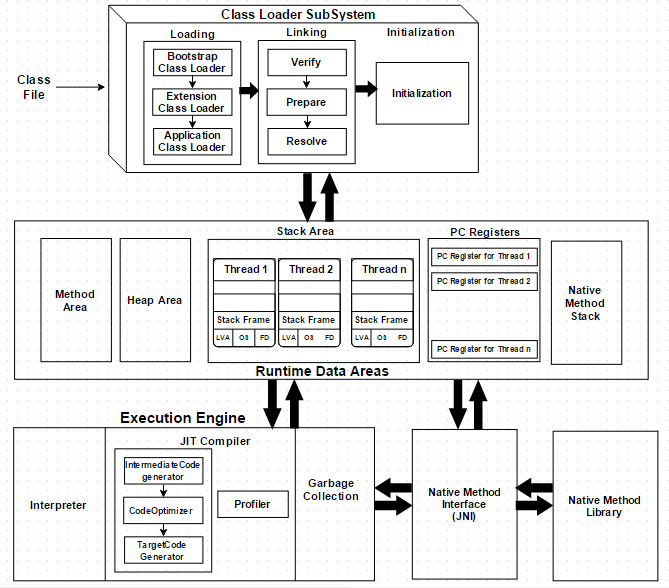The Unstoppable Evolution of the Java Platform
The Java ecosystem is evolving at an unprecedented pace. Gone are the days of waiting years for significant updates; the six-month release cadence has infused the platform with a continuous stream of innovation, making it more performant, developer-friendly, and robust than ever. While long-term support (LTS) versions like Java 11, 17, and 21 provide stable foundations for enterprises, the features previewed in interim releases offer an exciting glimpse into the future. This constant stream of Oracle Java news and OpenJDK news highlights a platform that is not just surviving but thriving.
This evolution extends far beyond core language syntax. Groundbreaking JVM-level projects are fundamentally changing how we write concurrent, high-performance applications. Projects like Loom, Panama, and Valhalla are not just incremental improvements; they represent paradigm shifts in concurrency, native code interoperability, and memory layout. For developers building data-intensive applications, these changes have profound implications, particularly in how Java interacts with relational databases. In this article, we’ll explore the latest advancements in the Java world, connecting them to practical, real-world database operations with concrete SQL and Java code examples. We will see how modern Java makes data access more efficient and scalable, reinforcing its position as a top choice for enterprise development.
Section 1: The Concurrency Revolution: Project Loom and Modern JDBC
For years, handling high numbers of concurrent I/O-bound tasks—like database requests—in Java was a complex challenge. The traditional one-thread-per-request model was resource-intensive, leading to scalability bottlenecks. The latest Java concurrency news is dominated by the arrival of Virtual Threads, the flagship feature of Project Loom, which became production-ready in Java 21. This is arguably one of the most significant pieces of Java 21 news.
Virtual threads are lightweight threads managed by the JVM, not the operating system. This allows a single OS thread to manage thousands of virtual threads, dramatically reducing the overhead of context switching. For an application that spends most of its time waiting for a database to return data, this is a game-changer.
Practical Example: Scaling Database Queries with Virtual Threads
Imagine an application that needs to fetch user profile data concurrently for multiple users. Using traditional platform threads, you’d quickly exhaust system resources. With virtual threads, you can spawn a new one for each request with minimal cost.
First, let’s define a simple database schema for our users. This SQL snippet creates the table we’ll be querying.
-- Schema for the 'user_profiles' table
CREATE TABLE user_profiles (
user_id VARCHAR(36) PRIMARY KEY,
username VARCHAR(100) NOT NULL UNIQUE,
email VARCHAR(255) NOT NULL UNIQUE,
full_name VARCHAR(255),
created_at TIMESTAMP WITH TIME ZONE DEFAULT CURRENT_TIMESTAMP
);
-- Insert some sample data
INSERT INTO user_profiles (user_id, username, email, full_name) VALUES
('a1b2c3d4-e5f6-7890-1234-567890abcdef', 'jdoe', 'j.doe@example.com', 'John Doe'),
('b2c3d4e5-f6a7-8901-2345-67890abcdef1', 'asmith', 'a.smith@example.com', 'Alice Smith');Now, let’s see how we can use Java’s new `Executors.newVirtualThreadPerTaskExecutor()` with classic JDBC to fetch this data concurrently. This approach allows us to handle many simultaneous database calls efficiently without resorting to complex asynchronous libraries.

import java.sql.Connection;
import java.sql.DriverManager;
import java.sql.PreparedStatement;
import java.sql.ResultSet;
import java.sql.SQLException;
import java.util.List;
import java.util.concurrent.ExecutorService;
import java.util.concurrent.Executors;
import java.util.concurrent.Future;
import java.util.stream.Collectors;
public class VirtualThreadDatabaseClient {
private static final String DB_URL = "jdbc:postgresql://localhost:5432/mydatabase";
private static final String USER = "user";
private static final String PASS = "password";
public static void main(String[] args) throws Exception {
List<String> userIds = List.of(
"a1b2c3d4-e5f6-7890-1234-567890abcdef",
"b2c3d4e5-f6a7-8901-2345-67890abcdef1"
);
// Use the new virtual thread per task executor
try (ExecutorService executor = Executors.newVirtualThreadPerTaskExecutor()) {
List<Future<String>> futures = userIds.stream()
.map(userId -> executor.submit(() -> fetchUserName(userId)))
.collect(Collectors.toList());
for (Future<String> future : futures) {
System.out.println("Fetched user: " + future.get());
}
}
}
public static String fetchUserName(String userId) {
System.out.println("Fetching user " + userId + " on thread: " + Thread.currentThread());
String sql = "SELECT username FROM user_profiles WHERE user_id = ?";
try (Connection conn = DriverManager.getConnection(DB_URL, USER, PASS);
PreparedStatement pstmt = conn.prepareStatement(sql)) {
pstmt.setString(1, userId);
try (ResultSet rs = pstmt.executeQuery()) {
if (rs.next()) {
return rs.getString("username");
}
}
} catch (SQLException e) {
e.printStackTrace();
}
return "User not found";
}
}Running this code will show that each `fetchUserName` call runs on a different virtual thread. This is a simple yet powerful demonstration of the latest Java virtual threads news, making scalable, I/O-bound code much easier to write and maintain.
Section 2: Declarative Data Management with Spring Boot and Hibernate
While JDBC provides fundamental database access, most modern enterprise applications rely on Object-Relational Mapping (ORM) frameworks. The Hibernate news and Jakarta EE news (the successor to Java EE) continue to focus on simplifying data persistence. Spring Boot, in particular, makes integrating with JPA (Java Persistence API) and Hibernate seamless through Spring Data JPA.
This declarative approach allows developers to focus on business logic rather than boilerplate SQL. You define your data model as Java objects (Entities) and your queries as interface methods.
Implementation Details: From SQL Schema to JPA Entity
Let’s expand our data model to include products and orders, a classic e-commerce scenario. First, we define the SQL schema, including a foreign key relationship.
CREATE TABLE products (
product_id BIGINT PRIMARY KEY GENERATED ALWAYS AS IDENTITY,
name VARCHAR(255) NOT NULL,
description TEXT,
price DECIMAL(10, 2) NOT NULL,
stock_quantity INT NOT NULL CHECK (stock_quantity >= 0)
);
CREATE TABLE customer_orders (
order_id BIGINT PRIMARY KEY GENERATED ALWAYS AS IDENTITY,
product_id BIGINT NOT NULL,
quantity INT NOT NULL,
order_date TIMESTAMP WITH TIME ZONE DEFAULT CURRENT_TIMESTAMP,
CONSTRAINT fk_product
FOREIGN KEY(product_id)
REFERENCES products(product_id)
);Next, we map these tables to JPA entities in Java. Notice how annotations like `@Entity`, `@Table`, `@Id`, and `@Column` link the Java fields directly to the database columns. This is central to the latest Spring Boot news and best practices.
import jakarta.persistence.*;
import java.math.BigDecimal;
@Entity
@Table(name = "products")
public class Product {
@Id
@GeneratedValue(strategy = GenerationType.IDENTITY)
@Column(name = "product_id")
private Long productId;
@Column(name = "name", nullable = false)
private String name;
@Column(name = "price", nullable = false)
private BigDecimal price;
@Column(name = "stock_quantity", nullable = false)
private int stockQuantity;
// Getters and Setters
}
// In a Spring Boot application, you would then define a repository:
import org.springframework.data.jpa.repository.JpaRepository;
import org.springframework.data.jpa.repository.Query;
import java.math.BigDecimal;
import java.util.List;
public interface ProductRepository extends JpaRepository<Product, Long> {
// Spring Data JPA creates the query from the method name
List<Product> findByPriceGreaterThan(BigDecimal price);
// For more complex queries, you can use the @Query annotation
@Query("SELECT p FROM Product p WHERE p.stockQuantity < :threshold")
List<Product> findLowStockProducts(int threshold);
}With this setup, developers can perform complex database operations by simply calling methods on the `ProductRepository` interface. The framework handles the SQL generation, connection management, and object mapping, dramatically improving productivity and reducing errors.
Section 3: Ensuring Data Integrity with Advanced Transactions and Indexing
In any critical application, ensuring data integrity is paramount. This is where database transactions come in. A transaction is a sequence of operations performed as a single logical unit of work. All of the operations must succeed; otherwise, the entire transaction is rolled back, leaving the database in its previous state. This “all or nothing” principle is a cornerstone of reliable systems.
Managing Transactions: SQL vs. Spring

In raw SQL, you manage transactions explicitly using commands like `BEGIN`, `COMMIT`, and `ROLLBACK`. For example, processing an order involves decreasing stock and creating an order record. These two actions must happen together.
-- Start a transaction
BEGIN;
-- 1. Decrease the stock for the purchased product
UPDATE products
SET stock_quantity = stock_quantity - 2
WHERE product_id = 1 AND stock_quantity >= 2;
-- 2. Create the new order record
INSERT INTO customer_orders (product_id, quantity)
VALUES (1, 2);
-- If both operations succeed, commit the transaction
COMMIT;
-- If an error occurred (e.g., insufficient stock), you would ROLLBACK;Writing this logic manually in Java can be verbose and error-prone. The latest Spring news emphasizes declarative transaction management using the `@Transactional` annotation. This powerful abstraction tells the Spring framework to automatically wrap the method call in a database transaction.
import org.springframework.stereotype.Service;
import org.springframework.transaction.annotation.Transactional;
@Service
public class OrderService {
private final ProductRepository productRepository;
private final OrderRepository orderRepository; // Assuming this repository exists
public OrderService(ProductRepository productRepository, OrderRepository orderRepository) {
this.productRepository = productRepository;
this.orderRepository = orderRepository;
}
@Transactional // This annotation handles BEGIN, COMMIT, and ROLLBACK
public void placeOrder(Long productId, int quantity) {
// 1. Find the product
Product product = productRepository.findById(productId)
.orElseThrow(() -> new RuntimeException("Product not found"));
// 2. Check for sufficient stock
if (product.getStockQuantity() < quantity) {
throw new RuntimeException("Insufficient stock"); // This exception will trigger a ROLLBACK
}
// 3. Decrease stock
product.setStockQuantity(product.getStockQuantity() - quantity);
productRepository.save(product);
// 4. Create the order
Order newOrder = new Order(productId, quantity);
orderRepository.save(newOrder);
// If the method completes without an exception, Spring will COMMIT the transaction
}
}Performance Tuning with Indexes
As your data grows, query performance can degrade. A common solution is to create a database index. An index is a data structure that improves the speed of data retrieval operations on a database table. When you run a query with a `WHERE` clause on an indexed column, the database can find the matching rows much faster.
For instance, if we frequently search for products by name, we should add an index to the `name` column.
-- Create an index on the 'name' column of the 'products' table
CREATE INDEX idx_products_name ON products(name);This simple SQL command can drastically improve the performance of queries generated by methods like `productRepository.findByName(“Laptop Pro”)`. This is a crucial piece of Java performance news: understanding the underlying database and its optimization features is just as important as writing efficient Java code.

Section 4: Best Practices and the Ever-Expanding Java Ecosystem
Staying current in the Java world means looking beyond the core language. The surrounding Java ecosystem news is filled with updates to build tools, testing frameworks, and exciting new domains like AI.
Key Considerations for Modern Java Developers:
- Choose the Right JDK: While OpenJDK is the reference implementation, various vendors provide production-ready builds with commercial support. Popular choices include Oracle Java, Adoptium Temurin, Azul Zulu, Amazon Corretto, and BellSoft Liberica. Choose one that fits your support and licensing needs.
- Master Your Build Tools: Keep up with Maven news and Gradle news. Understanding dependency management, build profiles, and plugins is essential for managing complex projects.
- Embrace Modern Testing: The latest JUnit news (JUnit 5) and Mockito news offer powerful features for writing clean, effective unit and integration tests. Test-driven development remains a cornerstone of high-quality software.
- Explore the AI Frontier: The rise of Generative AI has come to Java. New frameworks like Spring AI and LangChain4j are making it easier than ever to integrate large language models (LLMs) into your Java applications.
- Keep an Eye on the Future: Stay informed about upcoming JEPs (JDK Enhancement Proposals). Project Panama is simplifying native function calls, and Project Valhalla aims to bring more flexible and performant memory layouts with value objects. These projects will shape the future of high-performance Java.
Conclusion: A Thriving Platform for the Future
The Java landscape is more dynamic and exciting than ever. From the revolutionary impact of virtual threads on concurrency to the declarative power of modern frameworks like Spring Boot and Hibernate, Java continues to provide developers with powerful tools to build scalable, resilient, and maintainable applications. The key takeaway for developers is that modern Java development is a partnership between the JVM, the language, and the underlying data store. Understanding how new features like virtual threads optimize database interactions and how frameworks abstract—but do not eliminate—the need for well-designed SQL schemas and transactions is crucial for success.
As we look toward the future, the continuous innovation from the OpenJDK community and leaders like Oracle ensures that Java will remain a dominant force in enterprise software development. The best next step is to start experimenting. Upgrade a personal project to Java 21, refactor a blocking I/O call to use virtual threads, or explore the new AI libraries. The future of Java is here, and it’s built for performance.

